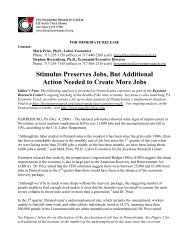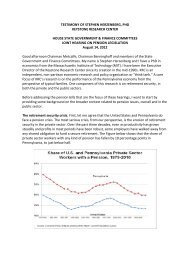The State of Working Pennsylvania 2004 - The Keystone Research ...
The State of Working Pennsylvania 2004 - The Keystone Research ...
The State of Working Pennsylvania 2004 - The Keystone Research ...
You also want an ePaper? Increase the reach of your titles
YUMPU automatically turns print PDFs into web optimized ePapers that Google loves.
<strong>The</strong> <strong>State</strong> <strong>of</strong> <strong>Working</strong> <strong>Pennsylvania</strong> <strong>2004</strong> 4<br />
Public Policy Barriers and Solutions<br />
Much <strong>of</strong> the blame for <strong>Pennsylvania</strong>’s and the nation’s slow jobs recovery lies with federal economic<br />
policy. <strong>The</strong> tax cuts that Congress enacted in 2001 and 2003 were generally tilted toward highincome<br />
taxpayers. Because high-income households save a larger percentage <strong>of</strong> their tax cuts than do<br />
low- and middle-income households, the tax cuts <strong>of</strong> 2001 and 2003 failed to stimulate the economy<br />
as much they would have if they had provided greater proportional tax relief to the less well <strong>of</strong>f.<br />
Federal policy has done little to stem the loss <strong>of</strong> manufacturing jobs. <strong>The</strong> value <strong>of</strong> the dollar remains<br />
high by historical standards, putting U.S. manufactured products at a competitive disadvantage.<br />
And U.S. trade agreements with low-income countries do not contain enforceable labor standards<br />
and other mechanisms to ensure that wages rise as these countries attain much higher productivity<br />
levels.<br />
Federal policy has also failed to raise the wages <strong>of</strong> low-wage earners. <strong>The</strong> federal minimum wage has<br />
not been increased since 1997. Since then the minimum wage has lost 8 percent <strong>of</strong> its purchasing<br />
power while productivity increased by 22 percent. And the work requirements in the federal welfare<br />
reform law pushed large numbers <strong>of</strong> people into the low-wage job market, slowing the growth <strong>of</strong><br />
wages at the bottom.<br />
At the state level in <strong>Pennsylvania</strong>, government has taken some steps to make the state a better place<br />
for working people.<br />
• Following a governor’s economic summit held in March, the Rendell Administration has<br />
begun to develop a manufacturing policy based on supporting companies to compete<br />
in higher-end markets more insulated from international price and wage pressures. 1<br />
A repositioning <strong>of</strong> this kind will take time and patience to yield results visible in the<br />
aggregate manufacturing job and wage numbers. This repositioning is nonetheless<br />
essential if the state is to slow down the long-term decline <strong>of</strong> manufacturing jobs and<br />
improve the quality <strong>of</strong> the jobs that remain. This repositioning is especially crucial for<br />
many <strong>of</strong> <strong>Pennsylvania</strong>’s smaller metropolitan areas and rural regions. In these regions,<br />
manufacturing still accounts for about one out <strong>of</strong> five jobs and remains the backbone <strong>of</strong><br />
the middle class.<br />
• <strong>The</strong> Rendell Administration has initiated a comprehensive reform <strong>of</strong> the state’s workforce<br />
programs. 2 <strong>The</strong> goals <strong>of</strong> this plan include:<br />
• linking workforce development more tightly with the skill needs <strong>of</strong><br />
<strong>Pennsylvania</strong>’s critical economic clusters, in significant part through the<br />
creation <strong>of</strong> industry training partnerships;<br />
• raising educational attainment, including by making postsecondary<br />
occupational training more accessible to older workers;<br />
• building new industry-linked career pathways that expand opportunity for<br />
workers.







